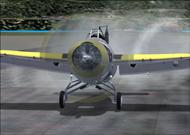AUTHOR: FSDS DRAWING AND TEXTURE BY JRLUCARINY
AUTHOR COMMENTS
This F4F-3 Wildcat of Fighting Seventy-Two (VF-72) carries the prewar color scheme of sprayed Silver lacquer fuselage and Yellow wings. It has the Black tail of USS WASP (CV-7) and the Yellow cowl and fuselage band of the sixth section leader.
HISTORY
In 1936 the US Navy evaluated a number of designs which were competing to be the Navy’s new carrier-based fighter. Grumman built a design which, after several re-designations and airframe modifications, won the contract and eventually became the F4F Wildcat. The prototype, the XF4F-2, first flew on 2 September 1937. The prototype of an improved version, the XF4F-3, was renamed the F4F and was ordered by the Navy in August of 1939. The first five aircraft off the assembly line were sent to Canada, with the next 90 (designated “Martlet Mk I” going to the 804 Squadron of the Royal Navy’s Fleet Air Arm where, in December 1940, two Martlets made history by becoming the first American-made aircraft to down a German plane in WWII.
The first US Navy F4F-3 was flown on 20 August 1940, powered by a Pratt & Whitney R-1830 engine with 1,200 horsepower. The subsequent F4F-4, incorporating several improvements including folding wings, six guns and self-sealing fuel tanks, was delivered in November 1941. It was then that the name “Wildcat” was first given to the F4F. As war raged around the world, the Wildcat’s reputation and utilization grew immensely. It flew with the US Navy and US Marines in all of the major Pacific battles, and in North Africa with the Navy.
In mid 1942, Grumman realized that it needed to concentrate on the production of its new F6F Hellcat fighter, and so it contracted with the General Motors Company to build the Wildcat under the designation FM-1. The first FM-1 flew on 31 August 1942, and over 1,150 of them were produced, hundreds of which went to the Fleet Air Arm as the “Martlet Mk V.” General Motors next developed an improved version, called the FM-2 (“Wildcat Mk VI” in the Fleet Air Arm), which was powered by a Wright R-1820 engine with 1,350 horsepower. It featured a taller vertical tail than the FM-1. Over 4,700 FM-2s were built before the Wildcat was eclipsed by the more capable fighters which appeared later in the war.
SPECIFICATIONS
Engine: 1200hp Pratt & Whitney R-1830-36 Twin Wasp, 14-cylinder radial piston engine
Weight: Empty 5760 lbs, Maximum Takeoff 7950 lbs.
Wing Span: 38ft. 0 in.
Length: 28ft. 9in.
Height: 9ft. 2.5in.
Performance:
Maximum Speed at 20,000ft: 318mph
Cruising Speed: 155mph
Service Ceiling: 39,500ft
Initial Climb Rate: 1950 feet/min.
Range: 770 miles
Armament:
Six 12.7-mm (0.50 in) Browning machine guns (FM-2 had four guns);
Two 100-lb bombs (FM-2 could carry two 250-lb bombs).
Number Built: 7,885 (All production variants)
Number Still Airworthy: ~18
COMMENT
I am always pleased when I see any aircraft of the second world war make it into FS2004. Not only am I interested in the history, but enthused about having a near complete collection. The chubby Wildcat, nicknamed ‘the peanut special’ by the British was the first American-made aircraft to down a German plane in WWII. The author captures the look of the Wildcat nicely, not only the chubby look of the plane but the complex landing gear assembly as well. Although the Wildcats were painted in dull colors, the author textures this model in bare metal. The sounds are default, no virtual cockpit, but a nicely done instrument panel. Flight characteristics are in line with the sluggish bird that had a cruising speed of roughly 155 MPH. Not very quick for a fighter. Over all the model is detailed very well but deserves a couple of liveries and a virtual cockpit to complete the aircraft. Nicely done.
My Rating 7/10








































